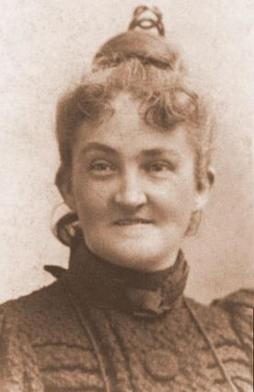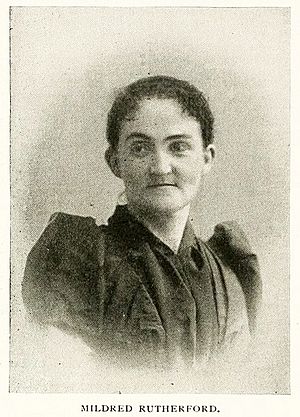Mildred Lewis Rutherford facts for kids
Quick facts for kids
Mildred Lewis Rutherford
|
|
|---|---|

"Miss Millie" Rutherford
|
|
| Born | July 16, 1851 Athens, Georgia, United States |
| Died | August 15, 1928 (aged 77) |
| Occupation |
|
Mildred Lewis "Miss Millie" Rutherford (born July 16, 1851 – died August 15, 1928) was an important educator and writer from Athens, Georgia. She held strong beliefs that white people were superior to others. She worked at the Lucy Cobb Institute, a school for girls, for over forty years. She helped add the Seney-Stovall Chapel to the school.
Mildred Rutherford was very active in many groups. She became the main historian for the United Daughters of the Confederacy (UDC). One of her speeches for the UDC was the first by a woman to be written down in the Congressional Record. She wrote many non-fiction books. She was also known for her speeches. Rutherford often dressed like a "southern belle" when she spoke. She strongly supported the Confederate States of America and believed that owning enslaved people was right. She also did not support women getting the right to vote.
Contents
Biography
Early Life and Family
Mildred Rutherford was born on July 16, 1851, in Athens, Georgia. Her mother was Laura Cobb Rutherford and her father was Williams Rutherford. Her father was a math professor at the University of Georgia.
Mildred's grandfather, John Addison Cobb, was a very wealthy man. He owned a large farm called a plantation. By 1840, he owned 209 enslaved people. He also invested in the Georgia Railroad and real estate. Mildred's uncles were also well-known. Howell Cobb was a Congressman and Speaker of the House. Thomas Reade Rootes Cobb was a lawyer who helped create Georgia's laws. He also wrote the state's wartime constitution in 1861. Thomas R. R. Cobb founded the Lucy Cobb Institute. He did this after Mildred's mother, Laura, sent an anonymous letter to a local newspaper.
Education and Career
Becoming an Educator
Mildred Rutherford started at the Lucy Cobb Institute when she was eight years old. She was part of the school's very first group of students. She finished her studies there in 1868 when she was sixteen.
After teaching in Atlanta for eight years, Rutherford became the principal of the Lucy Cobb Institute in Athens. This was from 1880 to 1895. She lived in a house across the street from the school until it burned down around 1926. She continued to work for the school for over forty years. She even served as its head again, with the title "president." This showed the school's goals to offer college-level education.
Rutherford took over a school that was struggling. She made it one of the best schools for young women in Georgia. She worked to improve how students learned. She also made the school buildings look better and increased the number of students. When she agreed to lead the school, Rutherford insisted on controlling the budget. She also wanted the power to hire and fire staff. The school's all-male board of directors agreed to her terms.
Building a Chapel
Mildred Rutherford believed the students needed a chapel. She had them write letters to ask for money to build one. In 1881, a student named Nellie Stovall wrote a letter to George I. Seney. He responded by giving $10,000 for the building. He also challenged the town to raise an extra $4,000. The building was an eight-sided red brick structure. It was named the Seney-Stovall Chapel.
Preparing Women for the Future
The Lucy Cobb Institute under Rutherford prepared women for more than just traditional home roles. The school knew that many of its graduates would need jobs. It taught students useful and respected skills. It also taught them proper manners and how to dress. This created a new image for educated white single women. It combined parts of the "new woman" and the "southern belle." This new image was called the "new belle." As early as 1885, a speaker at a Lucy Cobb graduation said that women should be allowed into more jobs.
A Talented Speaker and Historian
Rutherford was a very skilled public speaker. She often dressed as a southern belle when she gave speeches. She spoke to many local groups. These included the YMCA and the Ladies' Memorial Association. She was also president of the Ladies Memorial Association. She spoke to the Athens chapter of the United Daughters of the Confederacy (UDC). In November 1912, she spoke to the national meeting of the UDC as their historian general.
She became a well-known historian in the early 1900s. This was because of her many writings and speeches. She also published a historical journal from 1923 to 1927. She encouraged historical work among the UDC. She was their Historian General from 1911 to 1916. In 1916, she gave a speech at a UDC convention. This was the first speech by a woman to be printed in the Congressional Record.
Death and Legacy
In 1927, Rutherford became very sick. On Christmas night, while she was recovering, her house caught fire. The fire destroyed many of her personal papers and belongings. This included most of her private collection of items from the Confederacy. She died on August 15, 1928. She was buried in Oconee Hill Cemetery. Her great-niece, Mildred Seydell, was named after her. Mildred Seydell became a famous journalist. She was one of the first in Georgia and wrote for newspapers across the country.
A student dormitory at the University of Georgia is named after Mildred Rutherford.
Her Views and Beliefs
Mildred Rutherford was a Baptist and had strong religious faith. She cared a lot about proper behavior and morals. She showed this in her textbooks. She praised the writings of Southern authors and female writers.
Rutherford strongly supported the "Lost Cause" version of Southern history. This was a belief system that romanticized the Confederacy and its reasons for fighting the Civil War. It often ignored the role of slavery. Her writings aimed to show the South's contributions to U.S. history. She also tried to make secession seem right. Secession was when Southern states left the United States. She also presented the time before the Civil War, when slavery was common, in an ideal way. She defended American slavery. She believed its only problem was the burden it placed on white slaveholders.
She thought that "true history" could bring the North and South together. She also believed history was a powerful tool to support her causes. She was willing to change historical facts to make her point. In a speech in Dallas in 1916, she claimed that "the negroes in the South were never called slaves. That term came in with the abolition crusade." However, her own state of Georgia used the word "slaves" in its official Declaration of Causes of Secession. Historian David W. Blight said that she worked to defend the Confederacy with a passion similar to a government's propaganda efforts.
In 1914, she joined the Georgia Association Opposed to Woman Suffrage. She became a strong opponent of women's suffrage, which was the movement for women's right to vote. She also opposed the Nineteenth Amendment to the United States Constitution. This amendment gave women the right to vote and was approved on August 18, 1920. She believed that voting would not make women equal. Instead, she thought it would take away the only power they truly had. This was the power of a woman's influence and persuasion within her family. Rutherford never explained how this view fit with her own public and active life. Her opposition was very strong. Dolly Blount Lamar and Rutherford led the organization. In 1919, Georgia became the first state to reject the amendment. Rutherford opposed all changes to the Constitution. She believed they limited the power of the federal government.
Selected Writings
Mildred Lewis Rutherford wrote 29 important books and pamphlets. Many of these were printed at her own cost. They were read by many people.


